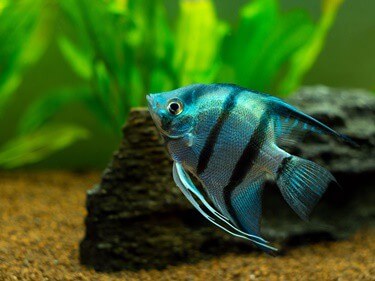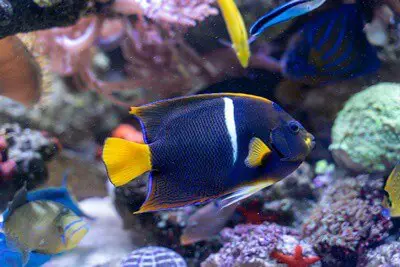You can tell how old an angelfish is by looking at its body size, the size of its eyes, and its behavior.
When fry, they’re 2 inches in height (0 to 3 months), 4 inches when juveniles (3 to 6 months), and 6 to 8 inches when adults (6 to 12 months).
If the eyes make up a large portion of the angelfish’s face, it’s most likely an underdeveloped adult. In terms of behavior, an angelfish nearing adulthood will fight with other fish.
How To Tell How Old An Angelfish Is
There are certain myths about how to age angelfish, so you can’t tell their age by the number of stripes they have in adulthood or how they change color.
Angelfish exhibit few physical indicators, and those that do exist are difficult to see. These may only give you a rough estimate at best.
There are other ways to guess an angelfish’s age, including its:
- Behavior.
- Body size.
- Eye size.
Behavior
Age is far easier to determine if you’re keeping angelfish in a community tank. They’ll display certain behaviors in social conditions that won’t be present when angelfish are alone.
Angelfish reach sexual maturity after 6-12 months. If your angelfish can be observed engaging in one or more of these behaviors, it means it is more than 6 months old.
Excessive Fin Twitching
Fin twitching can happen in male and female angelfish for two reasons: aggression and mating behavior.
Twitching of the fins occurs when an angelfish is particularly angry, which means that it wants to:
- Antagonize other fish.
- Warn them away.
The angelfish wants to evaluate compatibility. By flicking its tail, it’s signaling its physical prowess. When the mate performs its gesture, this allows the other angelfish to study its worthiness.
Fighting And Aggressiveness
Angelfish are from the cichlid family, which is a category of fish known for its aggressive behavior. Freshwater angelfish, the most common type of cichlid, is the least aggressive of the family, but they can still have a hostile attitude.
After reaching maturity, angelfish will begin fighting and antagonizing other fish. They do this by biting and forcefully colliding with other tank members.
This trait is most common in male angelfish, who display headbutting behavior and eat other fish. Females will also become hostile if they feel their mate is being threatened.
Cleaning Areas Of The Tank
You may notice an angelfish begins rubbing itself along the corners of the tank or clearing out pebbles, which means it’s getting the area ready to lay eggs.
Is this the first time your angelfish has exhibited this behavior? Then, it’s likely reached maturity and recently paired up with a mate, putting it at around the 6-month mark.
Pairing Up
Angelfish are monogamous and mate for life. When they find their partner, they stay close to protect and support each other.
Once paired up, the couple will often be seen swimming together, especially if the female is pregnant.
Sticking To One Area Of The Tank

This behavior is found chiefly in male angelfish. They do this to claim the territory and impress potential female mates, meaning they’ve reached sexual maturity and are ready to breed.
Body Size
Here’s an angelfish body size chart:
| Age | Height | Time |
| Fry (baby angelfish) | 2 inches | Birth – 3 months |
| Juvenile | 4 inches | 3 – 6 months |
| Adult | 6 inches – 8 inches | 6 – 12 months |
However, size heavily depends on how much food the fish has and its tank size. According to Fisheries Research, out in the ocean, with lots of food and space, angelfish can reach 17 inches.
With optimal conditions, an adult angelfish will be 6 inches.
Because of how tall it is, this fish needs a deep tank, at 32 inches or more. Any smaller and the angelfish may never grow to its full size. The same thing happens if the fish is underfed.
Of course, it may be hard to measure an angelfish’s height. Rarely do fish stay still right next to the wall of their tank. You can take a guess, but there are more accurate ways to estimate.
You can compare the fish with an American coin, which works well if the fish is younger.
| Coin | Size |
| Dime | 5/8 inch |
| Nickel | 7/8 inch |
| Quarter | 1 inch |
| Half Dollar | 1 ¼ inches |
| Silver Dollar | 1 ½ inches |
| Dollar Plus | 1 5/8 inches |
Eye Size
You can judge an angelfish’s age by its eye size. When they’re only a few weeks old, baby angelfish have large eyes, making up about 45% of their entire body.
Their eyes grow proportionately to the rest of the body as they age. The eyes of an adult angelfish make up less than 4% of their total body size.
So, what if you get an adult angelfish with bulging eyes (making up approximately 10-30% of the total body size)? It’s possible that it didn’t have the right tank conditions to develop.
The seller may explain that the fish is young. If you notice it doesn’t exhibit traditional mating behaviors, it could be a juvenile fish with stunted growth. You’ll have time to raise it in a big tank.
If the angelfish does exhibit some mating behaviors but is still small with large eyes, it’s likely an underdeveloped adult. Unfortunately, underdeveloped angelfish rarely reaches full maturity.
Myths About Determining an Angelfish’s Age
There are myths surrounding how to tell the age of an angelfish, such as the following:
Count The Number of Stripes
The number of stripes on an angelfish can change over time, making it an accurate way to tell its age.
However, the number of stripes on angelfish has nothing to do with how old they are. Instead, certain angelfish breeds developed stripes to ward off predators through camouflage.
Older Angelfish Have More Vibrant Colors
It’s common for people to buy a colorless angelfish that slowly brightens in color as time goes on.
Angelfish grow into their colors, which happens when they’re fry and continues until they reach their juvenile stage. However, once angelfish reach that juvenile stage, they don’t change in color just because they’re growing older.
Angelfish change color for the following reasons:
- Poor diet.
- Bad water quality.
- Stress.
- Aggressiveness.
- Illness.
- Self-defense.
- Mating rituals.
- Light conditions.

Why You Should Know An Angelfish’s Age
An angelfish’s age won’t impact how you care for them, but knowing this information has benefits:
Breeding
If you intend to breed your angelfish, you must know their age. Aging angelfish allows you to:
- Predict how long until they pair and breed.
- Determine when you’ll have new fry.
- Assess underdeveloped or sickly fish.
- Determine if fish are sterile or stunted.
Also, you may not want to breed your fish. Knowing their ages allows you to understand how long you have until they need to be separated. Otherwise, you may have territorial fights.
Estimating Lifespan
Knowing a fish’s age allows you to determine where it is in its lifespan.
If you sell the fish to other people, they may not want an old fish that will die shortly. If you’re keeping the fish, you may be interested in how many years are left until it dies.
Sentimentality
As with any pet, sentimentality counts. Knowing the fish’s age allows you to celebrate birthdays or understand if it’s a senior.
What to Do If You Can’t Determine the Age of Your Angelfish
Angelfish are a diverse species, so it can be hard to determine their age.
Here are some things you can do when unable to tell the age of your fish:
Find It A Partner
Angelfish act differently in social conditions than they do when alone. If you have a lone angelfish, it’s wise to get it a companion. By doing so, you can better gauge its behavior and reactions.
However, an angelfish won’t engage in mating behavior just because other fish are around. Instead, you should place one or two angelfish in the tank with them.
Several fish are recommended for these reasons:
- Even if your fish has another angelfish companion, they might be the same sex.
- The two may be incompatible, preventing them from participating in traditional mating rituals.
Take It To A Vet
If your angelfish is ill, that might cause some growth and behavioral issues. You can solve your fish’s health-related problems by taking it to the vet.
Some Fish Don’t Grow
Angelfish don’t all look and develop in the same way. Some will grow faster within a single fish tank, while others lag.
So, what if you can’t figure out the age of your angelfish because it won’t grow normally? After taking it to the vet and ensuring it’s healthy, it’s best to accept that it could be any age.
No matter their age, most angelfish should be cared for similarly.







